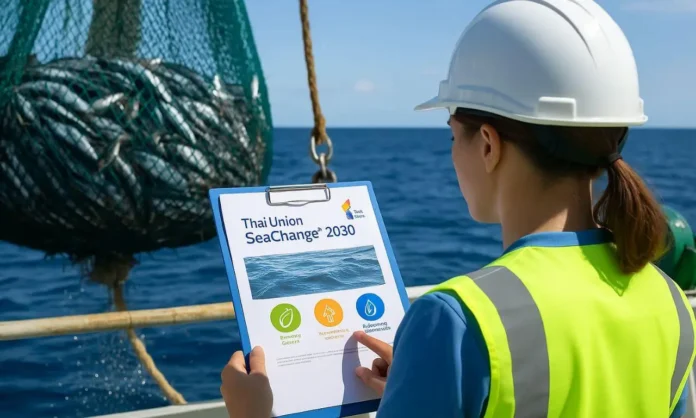At the 2025 UN Ocean Conference in Nice, Thai Union sent a clear message: the seafood industry must do more—and do it faster.
The company backed that call with action.
In its newly released 2024 Sustainability Report, Thai Union confirmed measurable progress across its global supply chain. From tuna traceability to emissions cuts to plastic waste recovery, the company’s SeaChange® 2030 strategy is not just a plan. It’s working.
“Safeguarding the ocean is a shared responsibility,” said CEO Thiraphong Chansiri.
“Through SeaChange, we’re showing what’s possible when sustainability is embedded in real business decisions.”
A Year of Real Progress
Thai Union is one of the world’s largest seafood producers. It supplies supermarkets, foodservice brands, and private label customers worldwide. That scale brings responsibility—and opportunity.
In 2024, the company reported:
98.9% of its tuna came from fisheries that are MSC-certified, in MSC assessment, or in credible improvement programmes
97% coverage of tuna vessels with on-the-water monitoring systems
A 21% cut in Scope 1 and 2 greenhouse gas emissions
23 out of 32 sites now send zero waste to landfill
A new Lower Carbon Shrimp Programme to lower Scope 3 emissions
234 tonnes of plastic removed from oceans and rivers
These are not small wins. They reflect multi-year investments and daily operational changes—from vessel tracking to factory waste sorting.
Accountability at Every Level
Thai Union’s SeaChange® 2030 plan is built around 11 commitments, covering climate, ecosystems, labour rights, and supply chain ethics. The company has pledged USD 200 million to deliver results by 2030.
“We’ve made real progress,” said Adam Brennan, Chief Sustainability & Communications Officer.
“But we can’t do it alone. Governments, suppliers, retailers—we all need to move faster if we want to meet global goals.”
The company’s targets align with UN Sustainable Development Goal 14, focused on ocean protection.
Competitive Position: Leading on Traceability and Emissions
Many seafood companies publish goals. Thai Union publishes data.
The firm leads on third-party verified traceability, emissions cuts, and circularity. Most of its competitors do not. Here’s how it compares:
| Sustainability Metric | Thai Union (2024) | Typical Competitor |
|---|---|---|
| Tuna traceability | 98.9% monitored | 60–75% (estimated) |
| Scope 1 & 2 GHG emissions | -21% | Not disclosed or partial |
| Zero landfill sites | 23 of 32 | Few disclose figures |
| Ocean plastic removed | 234 tonnes | Not tracked publicly |
Few match this level of transparency. Most firms do not provide public updates on vessel monitoring or factory waste outputs.
Why Retail Buyers Should Care
For supermarkets and private-label sourcing teams, Thai Union’s data makes their job easier. With stricter due diligence laws coming into force—especially in the EU—buyers need suppliers who already meet high ESG standards.
“Retailers need more than promises,” Brennan added.
“They need evidence. Our reporting gives them that.”
Thai Union also works directly with brands and retailers to customise sourcing data, packaging redesigns, and fishery improvement plans.
Partnerships That Shift the Industry
Thai Union helped launch the Protecting Ocean Wildlife pledge in 2023. It was the first to sign. Since then, governments and companies covering 15% of the global tuna supply have joined.
The company’s work with the Sustainable Fisheries Partnership, Greenpeace Southeast Asia, and national regulators has helped set new industry norms for bycatch monitoring, traceability tech, and science-based targets.
The Investment Backing It
SeaChange isn’t a brochure. It’s a business strategy—backed by serious capital.
Between now and 2030, Thai Union will invest USD 200 million to:
Expand digital vessel monitoring
Scale regenerative aquaculture
Decarbonise logistics
Fund plastic collection programmes in fishing communities
Launch biodiversity zones and circular packaging pilots
Each project is tracked and reported annually.
A Call to Act
The 2024 Sustainability Report closes with a direct appeal—not just to suppliers, but to governments, investors, and food brands.
“The ocean feeds billions. It regulates our climate. It sustains life as we know it,” said Chansiri.
“We can’t afford to take it for granted.”



